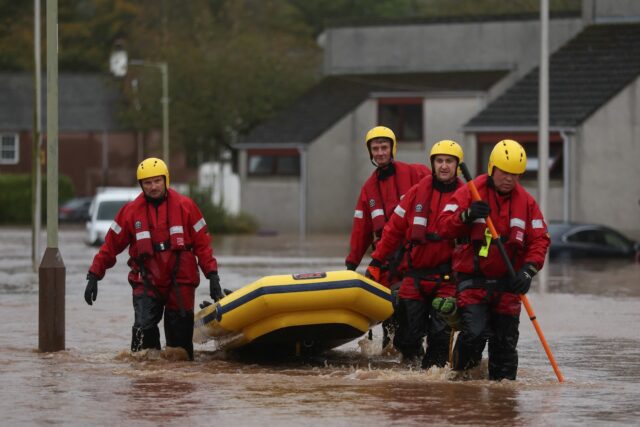From heatwaves to changing rainfall patterns, Europe continues to grapple with the ongoing impact of climate change. The recent ravaging run of “Storm Babet” through England and Scotland left the United Kingdom and the world in shock. It left a trail of destruction, claiming lives, causing widespread flooding, and disrupting essential services.
As the nation faces this unprecedented challenge, it is of immense importance to critically evaluate the impact and possible cause of the situation.
In this blog post, we will explore the situation surrounding the storm, and the flood that followed. We will also explore what the possible causes might be.
Fury of Babet Unleashed
The Met Office has issued warnings that more heavy rain is anticipated, adding to the existing challenges faced by the affected regions. The Environment Agency has identified over 90 flood warnings, with an emphasis on areas that are expected to receive additional rainfall. In England alone, approximately 1,250 homes have already been impacted, and an estimated 30,000 properties are in need of flood protections.
Rivers in Yorkshire and the Humber, as well as the East Midlands, experienced substantial breaches over the flood weekend, with numerous areas cut off by flooded roads. The River Severn, which plays a vital role in the drainage of these regions, is predicted to see further impact in the coming days. The gravity of the situation is underscored by the record-breaking water levels witnessed in the River Derwent, prompting evacuations in Derby and necessitating the closure of major roads.
In Scotland, the First Prime Minister, Humza Yousaf, visited the flood-hit town of Brechin in Angus, where dozens of homes succumbed to the rising waters of the River South Esk. Yousaf described the flooding as “unprecedented,” citing over a month’s worth of rainfall in a single weekend. The scale of the disaster has prompted urgent discussions about the support the government can provide, potentially including financial assistance for flood defence improvements.
The Cost on Properties and Human Lives
Storm Babet brought with it heavy rainfall and winds exceeding 70 mph. The Met Office issued its first red weather warning for rain since February 2020, predicting rainfall of up to 250 millimetres in some areas.
In Scotland, three lives have been claimed by the storm, highlighting the dangerous conditions it has created. A woman lost her life after being swept into a river, and a man succumbed to a falling tree hitting a van. Meanwhile, a search operation is underway in Aberdeenshire after reports of a man trapped in a vehicle in floodwater.
Additionally, over 100 individuals have been rescued from flooded areas. Dozens spent the night in emergency accommodations, facing uncertainty and dislocation. The toll on communities is evident, with more than 400 homes in Angus being evacuated, and schools closed as a precautionary measure
Similarly, Storm Babet has left its mark on transportation infrastructure, causing travel chaos across Britain’s rail networks. Train operators advised against travel on Saturday, and the runway at Leeds Bradford Airport was temporarily closed after a Tui plane skidded off amid heavy rain. London’s King’s Cross station experienced overcrowding and temporary closure due to disruptions in rail services. Network Rail implemented crowd control measures to manage the situation, indicative of the challenges faced by commuters.
Air travel was not spared either, with Leeds Bradford Airport temporarily closing after a plane skidded off the runway during high winds. Such incidents further compound the challenges faced by emergency services and underscore the storm’s widespread reach.
Storm Babet’s ferocity left around 4,000 people across the UK without power at some point. Scottish and Southern Electricity Networks reported progress in restoring power, with 36,000 customers reconnected. However, challenges persist as efforts continue to restore power, highlighting the resilience required to overcome the aftermath of such a storm.
The environmental toll of Storm Babet is visible in the destruction of a 200-year-old bridge on the Rottal Estate in Angus, washed away by torrential floodwater. Roads and bridges collapsed, and a road connecting Marykirk, Angus, also succumbed to the elements. Edzell, Angus, found itself cut off by floodwaters from three surrounding rivers, reflecting the vulnerability of infrastructure in the face of extreme weather events.

Understanding the Dynamics of Storm Babet
Storm Babet’s genesis can be attributed to a confluence of atmospheric conditions that have intensified its impact. One key element contributing to the severity of the storm is the unusual position of the jet stream, a high-altitude, fast-flowing air current that significantly influences weather patterns.
- The Jet Stream’s Unusual Position: According to Dr Hannah Cloke, professor of hydrology at the University of Reading, the jet stream’s atypical location is, in part, a consequence of a potent typhoon that struck Japan in the preceding week.
This disturbance altered the dynamics of the jet stream, forcing it into an abnormal configuration. The jet stream, a crucial player in European weather, is now positioned in a peculiar manner, exacerbating the impacts of Storm Babet. Such anomalies in the jet stream’s behaviour can have cascading effects on weather patterns, amplifying the intensity of storms and precipitation events.
- Climate Change’s Role in Intensifying Storms: While the immediate causes of Storm Babet are being dissected, the looming question of climate change’s influence cannot be ignored. Experts assert that although it is too early to draw direct connections, existing research underscores the role of climate change in amplifying extreme weather events.
How Does Climate Change Fit in?
Climate change has led to abnormal warming of both sea and air, creating a volatile environment conducive to the formation of powerful storms. Notably, the warmer seas possess more dynamic energy, providing the impetus for the development of destructive storms. Additionally, warmer air has a higher capacity to hold moisture, leading to increased rates of rainfall. This phenomenon has been observed in previous research, which establishes a direct link between rising global temperatures and the intensification of rainfall during storms.
The repercussions of climate change are not confined to localised effects but extend to large-scale atmospheric circulations, such as the jet stream. Studies indicate that global warming impacts, including the melting of ice and warmer oceans, can influence the speed and direction of these circulations.
The shifting patterns of the jet stream, as witnessed during Storm Babet, may be indicative of broader changes in the Earth’s climate system. These alterations can have far-reaching consequences, affecting weather patterns and contributing to the escalation of extreme weather events.
Adapting to a Changing Climate
As Storm Babet unfolds, it serves as a poignant reminder of the urgent need for climate adaptation measures. Communities, policymakers, and infrastructure planners must reassess their strategies to cope with the increasing frequency and intensity of extreme weather events. Investing in resilient infrastructure, implementing sustainable land-use practices, and formulating comprehensive disaster preparedness plans are crucial steps in mitigating the impact of future storms.
About CheckCarbonFact
CheckCarbonFact is a social accountability platform for climate action by citizens, companies, and governments. It is a UK-based enterprise with a focus on engendering collective responsibility and mutual accountability in climate change mitigation and adaptation. The vision of CheckCarbonFact is to mobilise collective action in the race to save the planet; and the mission is to deter greenwashing, empower sustainable consumerism; and address climate inequities and inequality.
Photo Credit: Reuters Emergency services assisting in the evacuating of people from their homes in Brechin, amid floods during “Storm Babet”, in Scotland, Britain October 20, 2023
Found it interesting and would like more in the mail?




